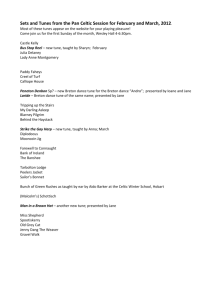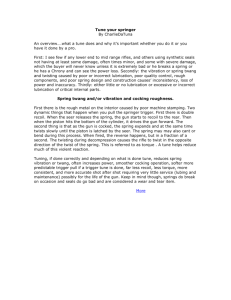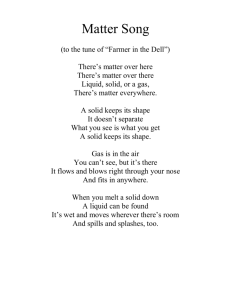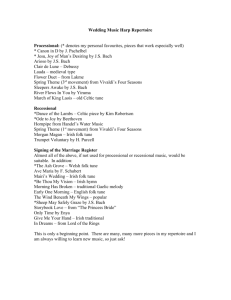a = 0
advertisement
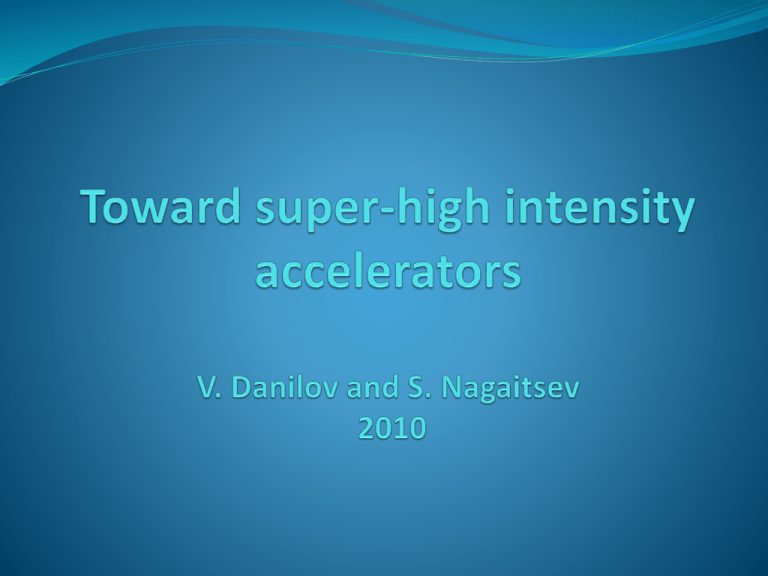
Acknowledgements Many thanks to Sasha Valishev (FNAL) for help and discussions. 2 Report at HEAC 1971 3 How to make the beam stable? Landau damping – the beam’s “immune system”. It is related to the spread of betatron oscillation frequencies. The larger the spread, the more stable the beam is against collective instabilities. External damping (feed-back) system – presently the most commonly used mechanism to keep the beam stable. Can not be used for some instabilities (head-tail) Noise Difficult in linacs 4 Most accelerators rely on both LHC Has a transverse feedback system Has 336 Landau Damping Octupoles Provide tune spread of 0.001 at 1-sigma at injection Lyn Evans: “The ultimate panacea for beam instabilities is Landau damping where the tune spread in the beam is large enough to stop it from oscillating coherently. ” Tevatron, Recycler, MI, RHIC etc. In all machines there is a trade-off between Landau damping and dynamic aperture. 5 Today’s talk will be about… … How to improve beam’s immune system (Landau damping through betatron frequency spread) Tune spread not ~0.001 but 10-50% What can be wrong with the immune system? The main feature of all present accelerators – particles have nearly identical betatron frequencies (tunes) by design. This results in two problems: I. II. Single particle motion can be unstable due to resonant perturbations (magnet imperfections and non-linear elements); Landau damping of instabilities is suppressed because the frequency spread is small. 6 Preliminaries I will discuss the 2-D transverse beam dynamics. I’ll ignore energy spread effects, but it can be included. The longitudinal coordinate, s, is equivalent to the time coordinate. H H x, y, p x , p y , s A 2-D Hamiltonian will be called “integrable” if it has at least two conserved functionally-independent quantities (analytic functions of x, y, px, py, s) in involution. A 1-D time-independent Hamiltonian is integrable. 7 A bit of history: single particle stability Strong focusing or alternating-gradient focusing was first conceived by Christofilos in 1949 but not published , and was later independently invented in 1952 at BNL (Courant, Livingston, Snyder). they discovered that the frequency of the particle oscillations about the central orbit was higher, and the wavelengths were shorter than in the previous constantgradient (weak) focusing magnets. The amplitude of particle oscillations about the central orbit was thus correspondingly smaller, and the magnets and the synchrotron vacuum chambers could be made smaller— a savings in cost and accelerator size. 8 Strong focusing Also applicable to Linacs x K x ( s ) x 0 y K y (s) y 0 K x, y (s C ) K x, y (s) -- piecewise constant alternating-sign functions s is “time” 9 Courant-Snyder Invariant z" K ( s ) z 0, z x or y Equation of motion for betatron oscillations Courant and Snyder found a conserved quantity: 2 1 2 ( s) I z z ( s) z 2 ( s) 2 where K (s) 1 3 -- auxiliary (Ermakov) equation 10 Normalized variables Start with a time-dependent Hamilatonian: H 1 2 p K (s) z 2 2 Introduce new (canonical) variables: z zN 1 -- new “time” (s) , p N p (s) Time-independent Hamiltonian: 1 2 H p N z N2 2 ( s ) z , 2 (s) Thus, betatron oscillations are linear; all particles oscillate with the same frequency! 11 First synchrotrons In late 1953 R. Wilson has constructed the first electron AG synchrotron at Cornell (by re-machining the pole pieces of a weakly-focusing synchrotron). In 1955 CERN and BNL started construction of PS and AGS. 1954: ITEP (Moscow) decides to build a strong-focusing 7-GeV proton synchrotron. Yuri F. Orlov recalls: “In 1954 G. Budker gave several seminars there. At these seminars he predicted that the combination of a big betatron frequency with even a small nonlinearity would result in stochasticity of betatron oscillations. ” 12 Yuri Orlov Professor of Physics, Cornell In 1954 he was asked to check Budker’s serious predictions. He writes: “… I analyzed all reasonable linear and nonlinear resonances with tune-shifting nonlinearities and obtained well-defined areas of stability between and below resonances and the corresponding tolerances.” Work published in 1955. 13 Concerns about resonances So, at the time of AGS and CERN PS construction (1955- 60) the danger of linear betatron oscillations were appreciated but not yet fully understood. Installed (~10) octupoles to “detune” particles from resonances. Octupoles were never used for this purpose. Initial research on non-linear resonances (Chirikov, 1959) indicated that non-linear oscillations could remain stable under the influence of periodic external force perturbation: z 2 sin( z ) a sin( t ) 0 0 14 First non-linear accelerator proposals In a series of reports 1962-65 Yuri Orlov has proposed to use non-linear focusing as an alternative to strong (linear) focusing. Final report (1965): 15 Henon-Heiles paper (1964) First general paper on appearance of chaos in a 2-d Hamiltonian system. 16 Henon-Heiles model Considered a simple 2-d potential (linear focusing plus a sextupole): U ( x, y ) 1 2 1 x y2 x2 y y3 2 3 There exists one conserved quantity (the total energy): E 1 2 ( p x p y2 ) U ( x, y ) 2 For energies E > 0.125 trajectories become chaotic Same nature as Poincare’s “homoclinic tangle” B 17 KAM theory Deals with the time evolution of a conservative dynamical system under a small perturbation. Developed by Kolmogorov, Arnold, Moser (1954-63). Suppose one starts with an integrable 2-d Hamiltonian, eg.: 1 2 1 2 2 H ( px p y ) (x y 2 ) 2 2 It has two conserved quantities (integrals of motion), Ex and Ey . The KAM theory states that if the system is subjected to a weak nonlinear perturbation, some of periodic orbits survive, while others are destroyed. The ones that survive are those that have “sufficiently irrational” frequencies (this is known as the nonresonance condition). The KAM theory specifies quantitatively what level of perturbation can be applied for this to be true. An important consequence of the KAM theory is that for a large set of initial conditions the motion remains perpetually quasiperiodic. 18 KAM theory M. Henon writes (in 1988): It explained the results Orlov obtained in 1955. And it also explained why Orlov’s nonlinear focusing can not work. 19 KAM for Henon-Heiles potential This potential can be viewed as resulting from adding a perturbation to the separable (integrable) harmonic potential. It is non-integrable. U ( x, y ) 1 2 1 x y2 x2 y y3 2 3 All trajectories with total energies E 1 ( p 2 p 2 ) U ( x, y) x y 2 are bound. However, for E > 0.125 trajectories become chaotic. B 0.1667 20 E = 0.113, trajectory projections 0.2 0.6 0.4 0.1 0.2 x - px pxi py i 0 y - py 0 0.2 0.1 0.4 0.2 0.2 0.1 0 0.1 0.6 1 0.2 0.5 0 xi 0.5 yi 1 0.5 x–y yi 0 0.5 1 0.2 0.1 0 xi 0.1 0.2 21 E = 0.144, trajectory projections 0.6 1 1 1 0.4 0.5 0.2 x - px pxi py i 0 y - py 0 0.2 0.5 0.4 0.6 1 0.5 0 0.5 1 1 1 0.5 0 xi 0.5 yi 1 0.5 x–y yi 0 0.5 1 1 0.5 0 xi 0.5 1 22 Accelerators and KAM theory Unlike Henon-Heiles potential, the nonlinearities in accelerators are not distributed uniformly around the ring. They are s-(time)-dependent and periodic (in rings)! … And non-integrable (in general). Luckily, an ideal accelerator is an integrable system and small enough non-linearities still leave octupole enough tune space to operate it. However, it was still not fully understood at the time of the first colliders (1960)… 23 First storage ring colliders First 3 colliders, AdA (1960), Princeton-Stanford CBX (1962) and VEP-1 (1963), were all weakly-focusing machines. This might reflect the concern designers had for the long-term particle stability in a strongly-focusing storage ring. CBX layout 24 Octupoles and sextupoles enter 1965, Priceton-Stanford CBX: First mention of an 8-pole magnet Observed vertical resistive wall instability With octupoles, increased beam current from ~5 mA to 500 mA CERN PS: In 1959 had 10 octupoles; not used until 1968 At 1012 protons/pulse observed (1st time) head-tail instability. Octupoles helped. Once understood, chromaticity jump at transition was developed using sextupoles. More instabilities were discovered; helped by octupoles and by feedback. 25 Tune spread from an octupole potential In a 1-D system: Freq. 1.5 H f ( W) 1 1-D freq. 0.5 0 0 1 2 3 W Energy 4 5 1 2 1 2 1 4 px x x 2 2 4 Tune spread is unlimited ----------------------------------------In a 2-D system: 1 2 1 2 1 4 2 2 H ( px p y ) ( x y ) x y 4 6 x 2 y 2 2 2 4 Tune spread (in both x and y) is limited to ~12% B 26 Tune spread from a single octupole in a linear latice Tune spread depends on a linear tune location 1-D system: Theoretical max. spread is 0.125 2-D system: Max. spread < 0.05 octupole 27 1 octupole in a linear 2-D lattice Typical phase space portrait: 1. Regular orbits at small amplitudes 2. Resonant islands + chaos at larger amplitudes; Are there “magic” nonlinearities that create large spread and zero resonance strength? The answer is – yes (we call them “integrable”) 28 McMillan nonlinear optics In 1967 E. McMillan published a paper Final report in 1971. This is what later became known as the “McMillan mapping”: xi pi 1 pi xi 1 f ( xi ) Bx 2 Dx f ( x) 2 Ax Bx C Ax2 p 2 B x 2 p xp2 C x 2 p 2 Dxp const If A = B = 0 one obtains the Courant-Snyder invariant 29 McMillan 1D mapping At small x: D f ( x) x C Linear matrix: At large x: 1 0 D 1 C Bx 2 Dx f ( x) 2 Ax Bx C 1 D acos 2 2 C Bare tune: f ( x) 0 A=1, B = 0, C = 1, D = 2 4 Linear matrix: 0 1 1 0 Tune: 0.25 2 p n k 0 Thus, a tune spread of 50-100% is 2 possible! 4 4 2 0 xn k 2 4 30 What about 2D optics? How to extend McMillan mapping into 2-D? Danilov, Perevedentsev found two 2-D examples: Round beam: xpy - ypx = const 1. Radial McMillan kick: r/(1 + r2) -- Can be realized with an “Electron lens” or in beam-beam head-on collisions 2. Radial McMillan kick: r/(1 - r2) -- Can be realized with solenoids (may be useful for linacs) In general, the problem is that the Laplace equation couples x and y fields of the non-linear thin lens 31 Danilov’s approximate solution McMillan 1-D kick can be obtained by using V ( x, y ) Re ln x iy 1 2 Then, f ( x,0) 2x x2 1 Make beam size small in one direction in the non-linear lens (by making large ratio of betafunctions) B 32 Danilov’s approximate solution FODO lattice, 0.25,0.75 bare tunes 2 nonlinear, 4 linear lenses. For beta ratio > 50, nearly regular decoupled motion Tune spread is around 30% . 33 Summary thus far In all present machines there is a trade-off between Landau damping and dynamic aperture. J. Cary et al. has studied how to increase dynamic aperture by eliminating resonances. The problem in 2-D is that the fields of non-linear elements are coupled by the Laplace equation. There exist exact 1-D and approximate 2-D non-linear accelerator lattices with 30-50% betatron tune spreads. 34 New approach See: http://arxiv.org/abs/1003.0644 The new approach is based on using the time- independent potentials. Start with a round axially-symmetric beam (FOFO) OptiM - MAIN: - C:\Documents and Settings\nsergei\My Documents\Papers\Invariants\Round V(x,y,s) V(x,y,s) V(x,y,s) 0 V(x,y,s) 0 V(x,y,s) DISP_X&Y[m] BETA_X&Y[m] 5 20 Sun Apr 25 20:48:31 2010 0 BETA_X BETA_Y DISP_X DISP_Y 40 35 Special time-dependent potential Let’s consider a Hamiltonian 2 x2 y2 p x2 p y V ( x, y, s) H K s 2 2 2 2 where V(x,y,s) satisfies the Laplace equation in 2d: V ( x, y, s ) V ( x, y ) 0 In normalized variables we will have: HN 2 2 p xN p yN 2 x N2 y N2 ( )V x N ( ) , y N ( ) , s( ) 2 ds (s) 0 s Where new “time” variable is (s) 36 Three main ideas 1. Chose the potential to be time-independent in new 2 2 p xN p yN variables x N2 y N2 HN 2 U (xN , y N ) 2 β(s) T insert 2. Element of periodicity (s) 1 0 0 0 k 1 0 0 0 0 1 0 0 0 k 1 L sk L s Lk 1 1 2 2 L s 3. Find potentials U(x, y) with the second integral of motion 37 Test lattice (for an 8-GeV beam) Six quadrupoles provide a phase advance of π Linear tune: 0.5 – 1.0 1 0 k 1 38 Examples of time-independent Hamiltonians V x, y , s Quadrupole q s 2 x 2 y2 U ( x N , y N ) q x N2 y N2 HN 2 quadrupole amplitude 1.5 q( s) 1 β(s) 0 0.2 0.4 0.6 s 2 x N2 y N2 q x N2 y N2 2 x2 02 (1 q) y2 02 (1 q) Tune spread: zero 0.5 0 2 2 p xN p yN Tunes: ( s) 0.8 L 39 Examples of time-independent Hamiltonians Octupole x 4 y 4 3x 2 y 2 V x, y, s 3 4 2 s 4 x N4 y N4 3 y N2 x N2 U 4 2 4 1 2 1 2 k 4 2 2 H ( px p y ) ( x y ) x y 4 6 x 2 y 2 2 2 4 This Hamiltonian is NOT integrable Tune spread (in both x and y) is limited to ~12% B 40 Tracking with octupoles Tracking with a test lattice 10,000 particles for 10,000 turns No lost particles. 50 octupoles in a 10-m long drift space 41 Integrable 2-D Hamiltonians Look for second integrals quadratic in momentum All such potentials are separable in some variables (cartesian, polar, elliptic, parabolic) First comprehensive study by Gaston Darboux (1901) So, we are looking for integrable potentials such that H Second integral: p x2 p y2 2 x2 y2 U ( x, y ) 2 I Apx2 Bp x p y Cpy2 D( x, y) A ay 2 c 2 , B 2axy, C ax 2 , 42 Darboux equation (1901) Let a ≠ 0 and c ≠ 0, then we will take a = 1 xyU xx U yy y 2 x 2 c 2 U xy 3 yU x 3xU y 0 General solution f ( ) g ( ) U ( x, y ) 2 2 x c 2 y 2 x c 2 y 2 2c x c 2 y 2 2c x c 2 y 2 ξ : [1, ∞], η : [-1, 1], f and g arbitrary functions 43 The second integral The 2nd integral 2 2 f ( ) g ( ) 2 I x, y, p x , p y xpy yp x c 2 p x2 2c 2 2 2 1 2 U ( x, y ) x y 2 2 Example: c2 2 2 f1 ( ) 1 2 c2 2 g1 ( ) 1 2 2 I x, y, p x , p y xpy yp x c 2 p x2 c 2 x 2 2 44 Laplace equation Now we look for potentials that also satisfy the Laplace equation (in addition to the Darboux equation): U xx U yy 0 We found a family with 4 free parameters (b, c, d, t): f 2 ( ) 2 1d t acosh g 2 ( ) 1 2 b t acos U ( x, y ) f ( ) g ( ) 2 2 45 The Hamiltonian So, we found the integrable Laplace potentials… 2 p x2 p y x 2 y 2 f 2 ( ) g 2 ( ) H x, y, p x , p y 2 2 2 2 2 2 F → 1 at x,y → ∞ → 0 at x,y → ∞ → ln(r) at x,y → ∞ c=1, d=1, b=t=0 c=1, b=1, d=t=0 c=1, t=1, d=b=0 46 F F The integrable Hamiltonian (elliptic coordinates) H p x2 p y2 2 x2 y2 kU ( x, y ) 2 Multipole expansion 2 8 16 128 2 4 6 8 x iy 10 ... U ( x, y ) Re x iy x iy x iy x iy 3 15 35 315 U(x,y): c=1, t=1, d=0, b 2 |k| < 0.5 to provide linear stability for small amplitudes Tune spread: x2 02 (1 k ) y2 02 (1 k ) x2 02 y2 02 at small amplitudes at large amplitudes Max. ~100% in y and ~40% in x B 47 Example of trajectories 25 nonlinear lenses in a drift space Small amplitude trajectories 0.04 0.04 0.02 0.02 pxjj py jj 0 0 0.02 0.02 0.04 0.04 0.04 0.02 0 0.02 0.04 0.02 0.04 xjj 0 0.02 0.04 y jj 0.6 y f1j 0.4 bare tune f2j f3j 0.2 0 0.5 x 0.6 0.7 0.8 j 0.9 1 48 Large amplitudes pxjj 2 2 2 1 1 1 py jj 0 1 2 2 y jj 0 1 1 0 1 1 2 2 2 0 1 0 xjj 1 2 2 2 1 y jj 0 1 2 xjj 40 bare tune y 30 f1j f2j 20 x f3j 10 0 0.5 0.6 0.7 0.8 j 0.9 1 49 More examples of trajectories f ( ) 4 2 1, and g ( ) 2 4 2 c=1, d=1, b=t=0 Normalized coordinates: Trajectory encircles the singularities (y=0, x=±1) 50 Polar coordinates Let a ≠ 0 and c = 0 2 p x2 p y r 2 g ( ) H f (r ) 2 2 2 2 r f (r ) d ln r g ( ) b sin 2 t cos2 I xpy yp x 2 g ( ) 2 51 Two types of trajectories f (r ) d ln r g ( ) b sin 2 t cos2 d = -1, b = 0, and t = 0.1 52 Parabolic coordinates a=0 Not considered by Darboux (but considered by Landau) I Apx2 Bp x p y Cpy2 D( x, y) A0 B y Cx Equation for potential: 2 xU xy 3U y y U yy U xx 0 53 Parabolic coordinates Solution f (r x) g (r x) , 2r (r x) f (r x) (r x) g (r x) I yp x xpy p y . 2r U ( x, y ) The only parabolic solution is y2 + 4x2 2 p x2 p y r 2 3 2 f ( r x) g 2 ( r x) H (x y 2 ) 2 2 2 2 10 2r Potentials that satisfy the Laplace equation f 2 (r x) b r x t r x 2 g 2 (r x) d r x t r x 2 54 Example of trajectories F U x, y 3 2 rx ( x y 2 ) 0.1 10 2r Trajectories never encircle the singularity 55 Summary The lattice can be realized by both and 1 0 1 0 M x, y M x, y k 1 k 1 Found nonlinear lattices (e.g. octupoles) with one integral of motion and no resonances. Tune spread 5-10% possible. Found first examples of completely integrable non-linear optics. Betatron tune spreads of 50% are possible. We used quadratic integrals but there are might other functions. Beyond integrable optics: possibly there exist realizable lattices with bound but ergodic trajectories 56 Conclusions Nonlinear “integrable” accelerator optics has advanced to possible practical implementations Provides “infinite” Landau damping Potential to make an order of magnitude jump in beam brightness and intensity Fermilab is in a good position to use of all these developments for next accelerator projects Rings or linacs Could be retrofitted into existing machines 57 Extra slides 58 Vasily P. Ermakov (1845-1922) Professor of Mathematics, Kiev university “Second order differential equations: Conditions of complete integrability”, Universita Izvestia Kiev, Series III 9 (1880) 1–25. Found a solution to the equation: z K ( s ) z 0 Ermakov invariant is what we now call Courant-Snyder invariant in accelerator physics 59 Joseph Liouville (1809-1882) Liouville (1846) observed that if the Hamiltonian function admitted a special form in some system of coordinates (u, v), the Hamiltonian system could be solved in quadratures. The form of the Hamiltonian function also implies additive separation of variables for the associated Hamilton-Jacobi equation. 60
